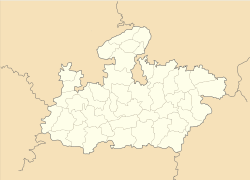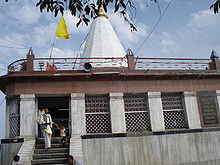- Maihar
-
Maihar — city — Coordinates 24°16′N 80°45′E / 24.27°N 80.75°ECoordinates: 24°16′N 80°45′E / 24.27°N 80.75°E Country India State Madhya Pradesh District(s) Satna Population 34,347 (2001[update]) Time zone IST (UTC+05:30) Area
• 367 metres (1,204 ft)
Maihar (Hindi: मैहर) is a city and a municipality in Satna district in the Indian state of Madhya Pradesh. Maihar is known for the temple of revered mother goddess Sharda situated on Trikuta hill of Maihar.
View from Sharda temple Maihar
Contents
Origin
There is a mythological story that explains the origin of Maihar. In later Hindu tales, Daksha is said to be a Prajapati or one of the Brahma's sons. One of his daughters (often said to be the youngest) was Shakti or Dakshayani, who had always wished to marry Shiva. Daksha forbade it, but she disobeyed him and did so anyway, finding in Shiva a doting and loving husband. Daksha disliked Shiva intensely, calling him a dirty, roaming ascetic and reviling the great yogi's cohort of goblins and ghouls. From then on, he distanced himself from his daughter, Dakshayani/Shakti, and his son-in-law, Shiva. This enmity culminated in a great sacrifice he had been hosting, one to which he invited all and sundry, family and allies, gods and rishis, courtiers and subjects. However, on seeing the shameless insult to her husband in his absence, and the repeated slights King Daksha and his courtiers railed at Shiva, she committed suicide in grief for her beloved. Hearing the news, Shiva's attendants rushed inside the ceremony hall and started attacking all the guests present there, however, the demons invoked by Bhrigu defeated Shivas attendants and they retreated back to his abode. Upon hearing the news of his beloved wife's death, Shiva was infuriated that Daksha could so callously cause the harm of his (Daksha's) own daughter in so ignoble a manner. Shiva grabbed a lock of his matted hair and dashed it to the ground. From the two pieces rose the ferocious Virabhadra and the terrible Mahakali. Upon Shiva's orders they stormed the ceremony and killed Daksha as well as many of the guests. Terrified and with remorse the others propitiated Lord Shiva and begged his mercy to restore Daksha's life and to allow the sacrifice to be completed. Shiva, the all-merciful One, restored Daksha's life, with the head of a goat.
Traces of something still more ancient are to be seen in the next act of this sacred drama, when Shiva, drunk with sorrow, strides about the earth, all destroying, bearing the form of dead Sati on his back. Then Vishnu, to save mankind, comes up behind Shiva and, hurling his discus time after time, cuts the body of Sati to pieces till the great god , conscious that the weight is gone, retires alone to Kailash to lose himself once more in his eternal meditation. But the body of sati has been hewn into fifty-two dices, and wherever a fragment touches earth a shrine of mother-worship is Shakti Peethas established.[1] It is said that when Shiva was carrying the body of dead mother goddess (Mai in Hindi) Sati, her necklace(har in Hindi) fell at this place and hence the name Maihar (Maihar = Mai+Har, meaning the necklace of mother).[2]
History
Maihar's history can be traced since the Paleolithic Age. The town was formerly the capital of the princely state of Maihar. The state was founded in 1778 by Rajputs of the Kachwaha clan, who were granted land by the ruler of the nearby state of Orchha. The state became a princely state of British India in the early 19th century, and was administered as part of Bundelkhand Agency in the Central India Agency. In 1871 the eastern states of Bundelkhand Agency, including Maihar, were separated to form the new agency of Bagelkhand in Central India. In 1933 Maihar, along with ten other states in western Bagelkhand, were transferred back to the Bundelkhand Agency. The state had an area of 407 square miles (1,050 km2), and a population of 63,702 in 1901. The state, which was watered by the Tons River, consists mainly of alluvial soil covering sandstone, and is fertile except in the hilly district of the south. A large area was under forest, the produce of which provided a small export trade. The title of the ruler was maharaja. The state suffered severely from famine in 1896–1897. Maihar became a station on the East Indian Railway (now the West Central Railway) line between Satna and Jabalpur, 97 miles (156 km) north of Jabalpur. Extensive ruins of shrines and other buildings surround the town.[3]
Sharda Devi Temple
The Sharda Devi Temple at Maihar
Apart from above there is a very famous temple by the name of Sharda Devi temple situated on the top of the a Trikuta hill around 5 km from the heart of the town. This temple is known for the 1063 steps to the top. Millions of devotees throng the temple all round the year. The introduction of Ropeway system from September 2009 has been a great boon to the pilgrims (particularly the old and the handicapped) to fulfill their wish to have the audience of Mother Goddess Sharda.
There is one ancient inscription near the feet of stone sculpture of Sharda Devi situated in Sharda Devi temple. There is another statue of Lord Narsingh along with Sharda Devi. These statues were installed by Nupula Deva on Shake 424 chaitra krishna paksha 14 Tuesday, vikram samvat 559 i.e. 502 AD. This stone inscription Sharda Devi in four lines is of size 15" by 3.5" in Devanagari script. Another stone inscription at the temple is of size 34" by 31" inscribed by a shaiva saint Shamba who had knowledge of Buddhism and Jainism also. This inscription bears a scene of Nāgadeva and reveals that it was about Damodara, son of Saraswati, was considered the Vyasa of Kaliyuga. And that there prevailed system of goat sacrifice at that time during worship. People can wath live darshan of Maa Sharda on http://www.maiharsharda.com which is hosted by anantworld satna.[4]
Local tradition reveals that the warriors Alha and Udal, who had war with Prithvi Raj Chauhan, are associated with this place. Both the brothers were very strong followers of Sharda Devi. It is said that Alha penanced for 12 years and got the amaratva with the blessings of Sharda Devi. Alha and Udal are said to be the first to visit the goddess in this remote forest. Alha used to call the mother goddess by the name 'Sharda Mai' and henceforth she became popular as 'Mata Sharda Mai'. One can see down hill behind the temple, the pond known as 'Alha Pond'. Recently this pond and the surrounding areas has been cleaned / renovated for the benefit of pilgrims. At a distance of 2 km from this pond is situated the akhara of Alha and Udal where they did practice of kusti.[5] One more famous fact about MAihar is that people of maihar believe that ALHA is still alive and every morning at 4 AM he comes to the temple and perform puja. Several people tried to watch him coming and doing puja but nobody till now has been succeeded.
Geography
Maihar is located at 24°16′N 80°45′E / 24.27°N 80.75°E.[6] It has an average elevation of 367 metres (1204 ft).
Demographics
As of 2001[update] India census,[7] Maihar had a population of 34,347. Males constitute 52% of the population and females 48%. Maiharreported an average literacy rate of 64%,male literacy is 72%, and female literacy is 56%. In Maihar, 15% of the population is under 6 years of age.and
Transport
Maihar is placed quite well as far as connectivity is concerned . It is connected via both major rail routes & NH 7 ( a national highway). The Mahakoshal Express provides a daily direct connection from Delhi's Hazrat Nizammudin station. Mahakoshal Train runs between Hazrat Nizamuddin station and Jabalpur stations situated about 162 KM away from Maihar. Maihar Railway Station is situated in between Katni and Satna stations of West Central Railway. During Nav Ratra festivals there is heavy rush of pilgims. Therefore during thse days all UP and DOWN trains stop at Maihar for convenience of passengers. The nearest Airports are Jabalpur and Khajuraho.
Industry
There is a 3.1 mn tn cement factory also near maihar (Maihar Cement Factory[8]) which provides an industrial touch to the holy place. The factory complex and the township is situated at Sarlanagar about 8 KM away from Maihar town on the Maihar-Dhanwahi Road.Two new cement factories KGS cement and Reliance cement are also setting up their cement factories here NTPC the power giant of india is also setting up a thermal plant at Barethi in Mahiyar [9] district in the Bundelkhand region of Madhya Pradesh.
Culture
Senia Maihar Gharana
Maihar has a prominent place in Indian classical music as the birthplace of the Maihar Gharana, a gharana (school or style) of Hindustani music. The greatest doyen of Indian Classical Music Ustad Allauddin Khan (died 1972) lived here for long time and was the court Musician of Maihar Maharaja's Palace; his students Shrimati Annapurna Devi (Alauddin Khan's daughter), Ustad Ali Akbar Khan (Alauddin Khan's son), Pandit Ravi Shankar (musician), Ustad Aashish Khan (Alauddin Khan's grandson), Ustad Dhyanesh Khan (Alauddin Khan's 2nd grandson), Ustad Pranesh Khan (Alauddin Khan's 3rd grandson), Ustad Bahadur Khan (Alauddin Khan's nephew), Timir Baran Bhattacharya (first student of of Allauddin Khan), Pt. Indranil Bhattacharya ( son of Timir Baran Bhattacharya), Vasant Rai (Last student of Alauddin Khan) Pandit Pannalal Ghosh, Pandit Nikhil Banerjee (Alauddin Khan's students) popularized the style in the 20th century.The First Ustad Allauddin Khan music conference was held by Shri Deep Chand Jain in 1962 In this conference the artists was ustad ali akbar,pt ravi shankar,pt ram narayan,pt shantaprasad,pt nikhil banerjee,ms saran rani,pt V.G jog etc.
References
- ^ Sister Nivedita & Ananda K.Coomaraswamy: Myths and Legends of the Hindus and Bhuddhists, Kolkata, 2001 ISBN 81-7505-197-3, p. 272
- ^ Maihar Darshan Guide (Ed. Laxmi Prasad Soni), Vidyasagar Book Stall, Satna, p. 5
- ^
 This article incorporates text from a publication now in the public domain: Chisholm, Hugh, ed (1911). Encyclopædia Britannica (11th ed.). Cambridge University Press.
This article incorporates text from a publication now in the public domain: Chisholm, Hugh, ed (1911). Encyclopædia Britannica (11th ed.). Cambridge University Press. - ^ Maihar Darshan Guide (Ed. Laxmi Prasad Soni), Vidyasagar Book Stall, Satna, pp. 6-8
- ^ Maihar Darshan Guide (Ed. Laxmi Prasad Soni), Vidyasagar Book Stall, Satna, pp. 8, 9, 23
- ^ Falling Rain Genomics, Inc - Maihar
- ^ "Census of India 2001: Data from the 2001 Census, including cities, villages and towns (Provisional)". Census Commission of India. Archived from the original on 2004-06-16. http://web.archive.org/web/20040616075334/http://www.censusindia.net/results/town.php?stad=A&state5=999. Retrieved 2008-11-01.
- ^ Maihar Cement, a BK Birla Group of Companies
- ^ [1]
Cities and towns in Rewa Division Rewa district Satna district Sidhi district Singrauli district Related topics Cities and towns
in other DivisionsFormer Princely States in Madhya Pradesh States Agar • Ajaigarh • Alipura • Alirajpur • Barwani • Bhopal • Bijawar • Chhatarpur • Datia • Dewas • Dhar • Gwalior • Indore • Jaora • Jobat • Khaniyadhana • Khilchipur • Kurwai • Maihar • Makrai • Narsighgarh • Orchha • Panna • Pathari • Piploda • Rajgarh • Ratlam • Rewa • Sailana • SitamauRelated topics Central India Agency • Bhopal Agency • Bhopawar Agency • Bundelkhand Agency • Saugor and Nerbudda Territories • Gwalior Residency • List of Indian princely states • List of Indian princely states (alphabetical) • Salute stateCategories:- Cities and towns in Satna district
- Satna
Wikimedia Foundation. 2010.





